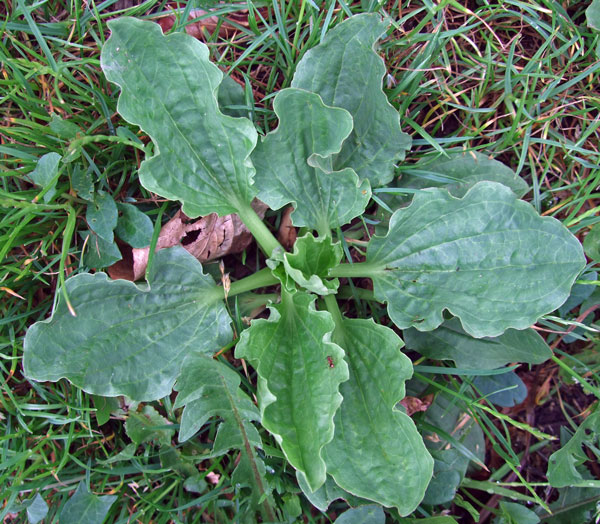 Botanical name: Plantago major
Botanical name: Plantago major
Family: Plantaginaceae
General information: Greater plantain or broad leaf plantain as it is often referred to, is a very common weed that frequently inhabits lawns and turf, especially heavily used areas that are suffering from soil compaction.
This perennial plant forms as a flat rosette that can easily tolerate close mowing, making it particularly troublesome in fine turf.
This turf weed spreads by seed and anchors itself to the ground with a fibrous but shallow root system. It is very common on compacted ground where grass growth is thin and sparse due to a lack of aeration.
It is rarely found on very wet or shaded sites. Greater plantain can withstand constant disturbance, often caused by traffic such as trampling or mowing.
Greater plantain has many medicinal uses, often used to heal skin ailments, including cuts, sores and eczema. It is also edible and used in salads when the leaves are young and tender, older leaves are somewhat tougher, but can still be used to make stews.
Greater Plantain Identification
- Leaves: The round to oval leaves typically measure 5 – 20 cm long and 5 – 10 cm across, however, in rare instances can grow larger. Each has several prominent veins running parallel from the base along the length of the leaf. The leaves are generally smooth, but it is not uncommon for them to have small, fine hairs on their surface. The younger leaves are soft and tender eventually turning tough and leathery as the plant matures.
- Flowers: The flowers are borne on long slender spikes or stalks ranging from 4 – 20 cm long (15 – 50 cm long including the stalk). The stalks produce green / white flowers, eventually turning into small capsule like seedpods that contain up to 20 seeds. When mature the seed pods break and the seeds falls on to the ground. The flowering period is usually between May and September.
- Roots: Greater plantain has a shallow fibrous root system (see image below).
Greater Plantain Images(click image to enlarge)
More images and free downloads of greater plantain
Prevention and control
Encourage a tight, healthy sward of grass with good turf care practices to prevent weeds from invading.
As this weed is common on compacted soils, employ a regular aeration program to relieve soil compaction.
Greater plantain can be removed by hand using a small implement such as a grubber or small pocket knife. Removal is often easier when the soil is on the moist side.
Using a spot weeder is very effective in controlling this weed. Spot weeders are available for purchase from all good garden centres and DIY stores. Simply spray the pre-mixed solution onto the weed.
If the infestation is widespread then most selective herbicides will prove effective in controlling greater plantain, as it is relatively easy to kill. A single treatment should suffice. Greater plantain is susceptible to almost all chemicals used in selective weed killers.
Selective herbicides recommended for the control of greater plantain
Professional products (The user requires the appropriate certificate/s to apply these products)
Headland Relay Turf (Mecoprop-p, Dicamba, MCPA)
Headland Cabadex (Fluroxypyr, Flurosulam)
React Ultra (Mecoprop-p, Dicamba, MCPA)
Everris Praxys (Clopyralid, Fluroxypyr, Fluosulam)
Bayer Longbow (Mecoprop-p, Dicamba, MCPA)
Barclay Holster XL (2,4-D, Fluroxypyr, Dicamba)
Mascot Greenor (Clopyralid, Fluroxypyr, MCPA)
Mascot Junction (2,4-D, Flurosulam)
Mascot Crossbar (2,4-D, Flurosulam, Dicamba)
Vitax Esteem (2,4-D, Clopyralid, MCPA)
Products available for non-professional use (These products are available from garden centres and DIY stores)
Verdone extra (Clopyralid, Fluroxypyr, MCPA)
Resolva lawn weed killer (2,4-D, Mecoprop-p, MCPA, Dicamba)
Doff lawn spot weeder (2,4-D, Mecoprop-p, Dichlorprop-p)
Vitax Lawn Clear (2,4-D, Clopyralid, MCPA)
Vitax Green up weed & feed (Dicamba, MCPA)
Weedol lawn weed killer (Clopyralid, Fluroxypyr, MCPA)
Scotts lawn builder weed & feed (2,4-D, Dicamba)





